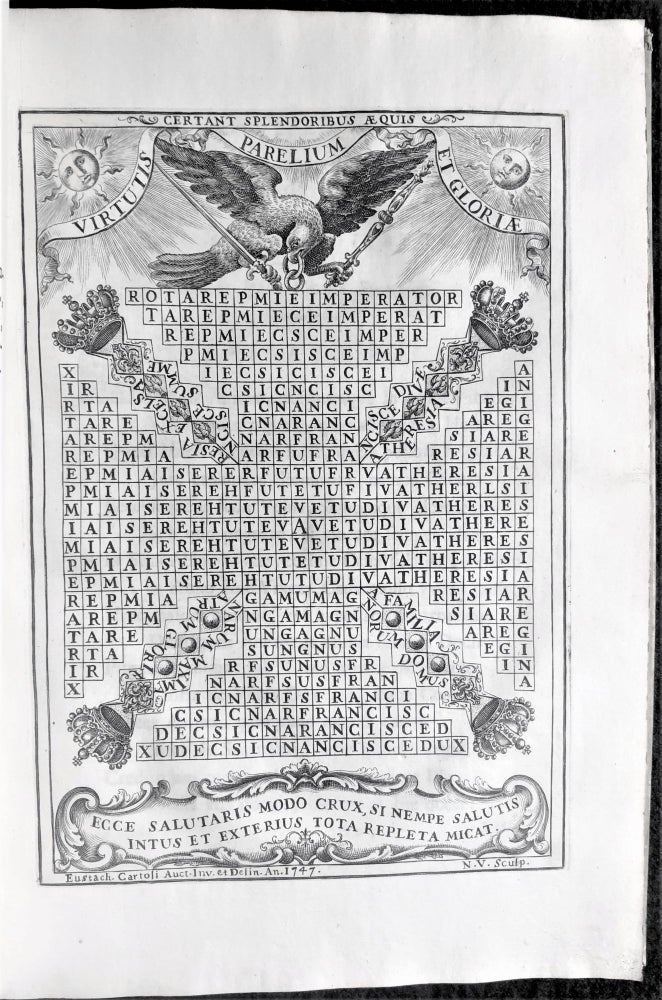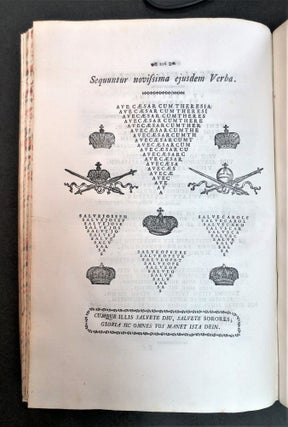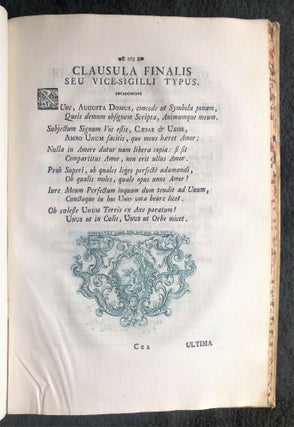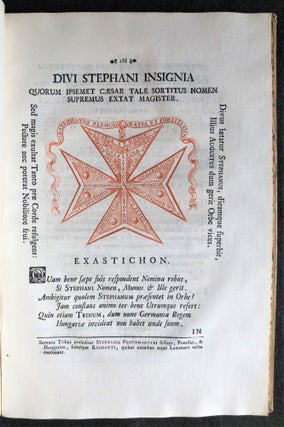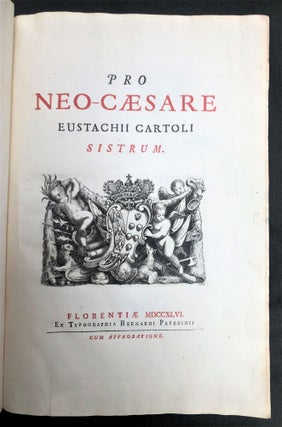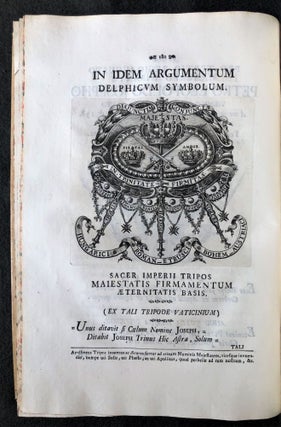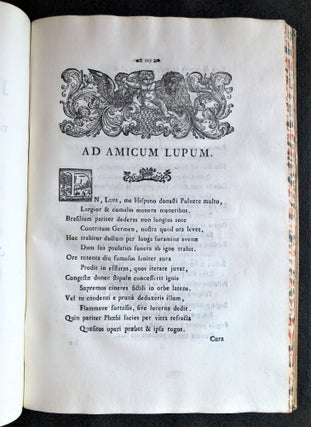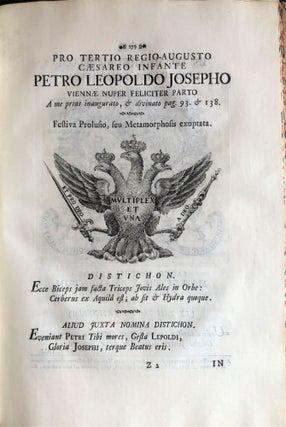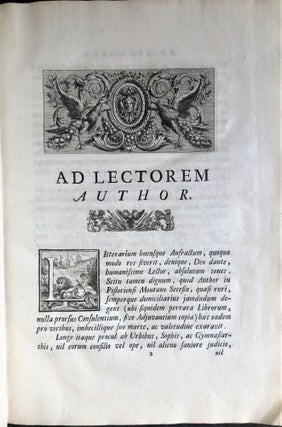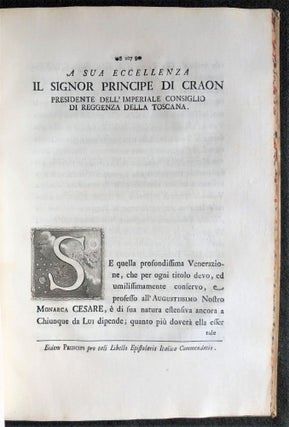Pro Neo-Caesare ... Sistrum. Florence: Bernardus Paperinus, 1746 [i.e., 1749].
Folio (348 x 231 mm). 144 leaves, paginated [8], 1-74 [1 leaf] 75-164 [1 leaf], 165-170 [1 leaf] 171-174 [1 leaf] 175-186 [3 leaves, the second and third foliated 187 and 188] 189-267 pp. Title printed in red and black with large engraved arms of the honoree Francis I, Grand-Duke of Tuscany and recently elected Holy Roman Emperor, one full-page engraved “crossword” on Aa2r signed by N. V. [not identified] after Eustachio Cartoli and dated 1747, five large engravings of which four armorial or emblematic, including one printed in green and one (the insignia of the Order of St. Stephen) in sepia, and engraved portrait of the author in 1722, signed with monogram of Pietro Antonio Pazzi and dated 1749; 3 large engraved head-pieces and an engraved tail-piece, 5 engraved pictorial initials, and typographic vignettes, ornaments, initials and head- and tail-pieces; eleven printed correction slips. Small black (ink?) marks in upper margins of pp. 44-45, small light stain in gutter of p. 163, else a fresh copy. Contemporary parchment over pasteboards, title gilt lettered on spine, edges mottled blue and red (covers bowed). Provenance: Castello di Duino, 20th-century bookplate, typed shelfmark label (the contents of the castle were sold by its owners, the Thurn und Taxis family, in June 1997 by the Paris auctioneers Beaussant Lefèvre, but the books seem to have been sold separately).***
Only Edition of a cornucopia of wordplay and playful settecento typography, composed in honor of the Grand-Duke of Tuscany, Francis I (1708-1765), recently crowned Holy Roman Emperor. Originally Duke of Lorraine, a title he had exchanged in 1736 for the Duchy of Tuscany (under political pressure from the then Emperor, his father-in-law Charles VI), in his Imperial capacity Francis gracefully deferred to his wife (and cousin) Maria Theresa of Austria in affairs of state, restricting himself to financial matters, which he managed astutely.
The sistrum of the title was a percussive musical instrument, here shaken loudly for the new Caesar. That Francis I shared a smattering of Medici blood with his distant cousin the previous Duke of Tuscany, Gian Gastone de’ Medici (1671-1737), no doubt helped inspire sincere reverence from his Tuscan subjects. Little is known of the author, other than his residence, described in a note to the reader, in the village of San Marcello in the hill country northwest of Florence. He is referred to as Dottore in his only other published work, an edition of sonnets published in 1730.
Written in Latin verse, with prose sections in Italian, the elegantly printed work, filled with engraved, woodcut and typographic ornaments and with a few words printed vertically or sideways, contains acrostics, anagrams, letter-number ciphers, chronograms, palindromes, riddles, verbal emblems, epigrams and other types of word-play. A nine-page description of the Imperial entry into Vienna (presumably following the coronation) opens the work, followed by festive poems including a series of “homages” from the rivers of Tuscany, and dozens of laudatory distichs and epigrams, grouped thematically and by honoree. The central section consists of 12 “little gifts” or series of poems in various genres, dedicated to and praising a dozen members of the Imperial family, followed by poems in honor of other poets, some borrowing from or modeled on classical authors (mainly Martial and Horace). The full-page engraving contains an imperial cross-shaped crossword-like series of double palindromes, all phrases saluting the Emperor and Empress, starting with the central letter A and readable in various directions; the cross is transfixed by four crowned scepters, composed of fleurs-de-lis, eagles, imperial orbs, and words, and the entire assemblage is held aloft by an eagle. Another palindromic construction, in triangular form, is typographic (p. 226).
The edition seems to have evolved over several years: while the title is dated 1746, later dates appear on the full-page engraving (1747), Cartoli’s note to the reader (May 1748), and Pazzi’s portrait of the author (1749). The author was evidently closely involved with the book’s mise-en-page, no doubt the source of compositional complications which led to the irregular pagination. As the following collation shows, three of the unnumbered leaves were insertions, added to the text quires, but the three unpaginated leaves after fol. 186 (fol. Aa1v), including that with the full-page engraving, are part of quire Aa: A4 a2 A-I4 K4 (K1+1) L-T4 X4 (X2 + 1) Y4 (Y3 + 1) Z4 Aa6 Bb-Hh4 Ii6 Kk4.
Rare: OCLC lists copies at Houghton, the BL and Glasgow; ICCU adds four Italian locations. Item #4075
No longer available

